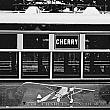Death of the Streetcar in Grand Rapids
by Michael Knopf
Before the mid 1920s there was nothing exceptional about Grand Rapid’s streetcars, until the new General Manager began a massive modernization campaign. Ironically, it is in this that the groundwork for the end seems to have been laid. The campaign to modernize the streetcars was not only for the streetcars themselves but the tracks they rode on. Years of thoughtless track laying had created a jumbled mess across the city that was neither efficient nor profitable. Along with creating a more comfortable streetcar, the company proposed to relay the entire system so that every portion of the city was accessible.
While an inefficient reputation and so-so attitude towards its rider’s convenience had worked well enough for the streetcar companies in previous decades, the 20’s saw the growing popularity of the automobile. The motorcar’s versatility and style soon captured the imagination of the American population and streetcars correspondingly saw their riders and their profits decrease. The modernization campaign by the Grand Rapid’s Streetcar Co. was literally a last ditch effort to draw back riders before expenses became too great. For awhile, it seemed to work. In 1927 the city began an expansive urban reform project, which involved widening roads in order to accommodate automobile traffic as well as to lay tracks according to the new plan that would cover the entire city. The ultimate plans for the streetcar system were never realized however, due to the untimely arrival of the Great Depression in 1929.
Public funds which were necessary to lay the expensive track in their new locations dried up as the city groaned under economic strain. It was in this atmosphere that the decision was made to abandon the streetcar system and replace it with buses. The street widening program continued, only now the tracks were torn from the ground and sold as scrap metal to help the city’s floundering budget. Buses, whatever other faults they may have had, could at least run on the same roads as normal cars, and did not require a separate and expensive network to support them. Had the city never attempted to modernize its streetcar system it is possible it may have struggled on for several more years, as happened elsewhere. On the other hand, if the final plan had been completed, the streetcars may have proven to be a financial success and inspired other cities to follow in its path.
Whatever arguments went on behind closed doors are unknown, but it is known the first downtown bus route began operating in 1932. The Grand Rapids Railway Company went into receivership that same year. Buses had originally been intended as temporary measures until rails could be laid, but now in the light of financial despair, the opposite had occurred. The road project that had begun with such optimism a few years before was now faced with a dilemma. Why continue to pay for rails when it was obvious the company was allowing buses to take over the lines? As more road was torn up and rebuilt, no rails were supplied to replace the old as had been intended. By 1934 the end was inevitable. That year the Committee on Public Services requested all streetcars be replaced by buses in one year.
Though the streetcars had officially been condemned it was not until the following year that judgment was finally passed. On August 23, 1935 the last streetcar made a lonely final run along the Cherry Street route. No exuberant speeches or fiery festivals marked the occasion. Ever the showman, DeLamarter built up suspense until the people of Grand Rapids awoke to the “surprise” that their railroad was now a bus route. Eighteen buses, only eight of them new, had been hidden in garages to be unleashed to the public at once. The buses were freshly painted and the drivers wore new suits. It was an underwhelming event compared to the grand spectacle that had greeted the new streetcars nine years earlier. Streetcar operators in Mexico and South America quietly purchased some of the cars, while most of the others went to scrap yards. W.P.A. workers tore up the remaining tracks. After seventy years of service, including horse cars, cable cars, steam cars, and electric cars, the Grand Rapids Railway Co. closed up shop, making Grand Rapids the second city in the nation to convert to bus.

 facebook
facebook



